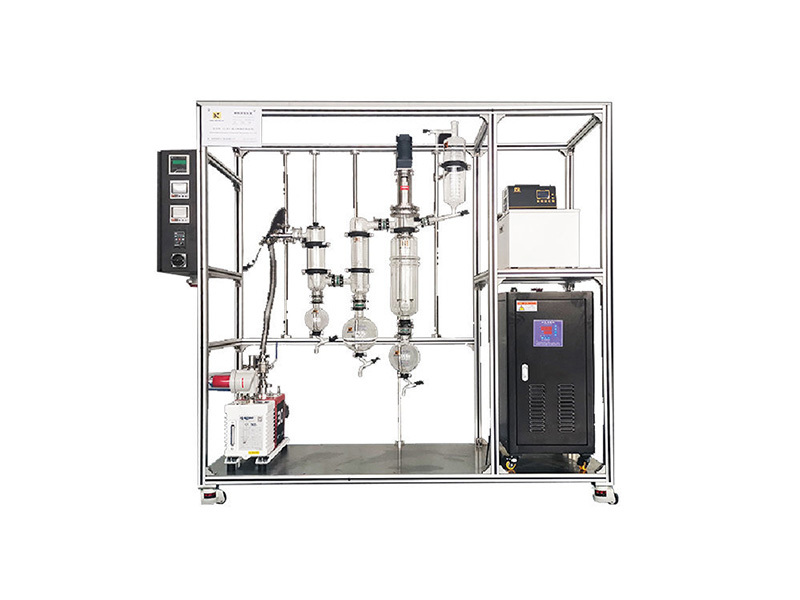Working principle of continuous distillation unit
Release Time:
2022-12-20
Pageviews:
The rectification tower provides vapor-liquid two-phase contact for interphase mass transfer. The condenser at the top of the tower condenses the vapor partially, and part of the condensed liquid returns to the top of the tower as reflux liquid, and the rest of the distillate is the top product of the tower. The reboiler located at the bottom of the column vaporizes part of the liquid, the vapor rises up the column, and the remaining liquid is used as the bottom product. The feed is added in the middle of the tower, the liquid in the feed and the liquid from the upper tower descend down the tower together, and the vapor in the feed rises along the tower with the vapor from the lower tower. In the whole rectification column, the gas-liquid two-phase contacts in countercurrent to carry out interphase mass transfer. The volatile components in the liquid phase enter the vapor phase, and the less volatile components in the vapor phase transfer to the liquid phase. For systems that do not form azeotropes, as long as the design and operation are proper, the distillate will be a high-purity volatile component, and the bottom product will be a high-purity non-volatile component. The tower section above the feed inlet further concentrates the volatile components in the rising vapor, which is called the rectification section; the tower section below the feed inlet extracts the volatile components from the descending liquid, called the stripping section. The combination of two stages of operation can completely separate the two components in the liquid mixture and produce two products with the required purity.

The reason why continuous distillation can separate the liquid mixture more completely lies in the application of reflux. The reflux includes both a liquid with a high concentration of volatile components at the top of the column and a vapor with a high concentration of less volatile components at the bottom of the column to return to the column. The vapor-liquid reflux forms a vapor-liquid two-phase in countercurrent contact, so that relatively pure single-component products are obtained at both ends of the tower. The ratio of the amount of liquid flowing back into the tower at the top of the tower to the amount of the top product is called the reflux ratio, which is an important control parameter for the rectification operation, and its change affects the separation effect and energy consumption of the rectification operation.
Latest News
2024-09-03
Abstract: Oil deacidification is an important step in food processing, which aims to remove free fatty acids in oil and improve its quality and stability. Traditional deacidification methods have some limitations, such as low efficiency, high energy consumption, and loss of nutrients. In recent years, molecular distillation technology has gradually attracted attention as a new deacidification method. This article will introduce the application of molecular distillation in oil deacidification, including the principle, operation process and advantages, and focus on the outstanding advantages of Aishengke in molecular distillation technology.
Vitamins are products that are closely related to people's lives, and have become one of the main bulk products in the international pharmaceutical and health care products market. The amount of vitamin E is the largest, followed by vitamin A, vitamin C, vitamin D and so on. With the growth of economy and the improvement of people's living standards, the demand for vitamin products will further increase, and people's requirements for their quality and grade will also further increase. Therefore, as an important separation technology in the production of many vitamins, molecular Distillation technology will also play an increasingly important role in the vitamin industry.
Glyceryl monostearate (GMS), abbreviated as monoglyceride, is produced from natural vegetable oils and fats. The active ingredient is purified by molecular distillation technology to more than 90%, also known as molecular distillation monoglyceride. It is the most widely used food Additives, safe to use in the production and processing of food, medicine, plastics, etc., account for more than half of the emulsifier consumption in the market.
The principle of molecular distillation is to make use of the different degrees of affinity between different molecules. By controlling the conditions such as temperature and pressure, the mixture begins to vaporize. Different components in the vapor form liquids in the condenser and are separated according to their boiling points. This distillation method not only has a good separation effect, but also can be repeatedly separated and purified, and is widely used in chemical, pharmaceutical and other fields.
Molecular distillation is a common chemical method used to separate and purify compounds. In the pharmaceutical industry, molecular distillation is widely used in pharmaceutical purification. This article will focus on the application of molecular distillation in pharmaceutical purification and provide some specific examples.
Laboratory vacuum distillation equipment has undergone significant advancements in recent years, driven by the need for higher efficiency, improved safety, and enhanced user experience.
Global recruitment of distributors
If you recognize the brand, technology, products and market prospects of Aishengke, we look forward to establishing a strategic partnership with you for win-win cooperation and development. Looking forward to your joining!

